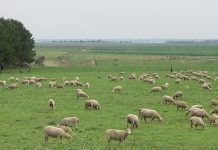Good broiler management will ensure better feed conversion ratio, body weight and ‘liveability’ at slaughter age. Constant, close observation is one way a broiler manager can ensure the chickens are comfortable, says poultry expert Bruce Gibson.
Early environment
Brooding, or the heating of the chicks for their first 21 days in the broiler house, is important. Bruce advises managers to make sure the chicks don’t have to compete for space under the gas or electric brooders. “Incorrect brooding results in the stronger chicks forcing weaker chicks away from the heat source,” says Bruce. “These weaker chicks are then likely to remain stunted in their growth for the rest of the growing period.”
This is because they have to convert feed into body heat to try and stay warm. Chicks may also die, or injure themselves or other chicks, as they climb over each other to try and get closer to the heat source, adds Bruce. Broiler chicks should not have to huddle tightly together under brooders, because if the chicks in the middle of the huddle get too warm they won’t be able to move away to a cooler spot.
Chick comfort
If the temperature is comfortable for stronger and weaker chicks, competition is reduced and size and weight uniformity across the flock improves. “Chicks in a broiler house should be free to move and to find their temperature comfort zone,” explains Bruce. Chicks under 21 days old hate cold draughts. And many broiler managers new to the business won’t realise a draught is bothering their broiler chicks unless they have learnt to observe the chicks’ behaviour, he adds.
Bruce says that if a large section of floor space is clear, there’s likely to be a draught, as the chicks will move away from the draught, which usually enters at floor level. “Seal all holes at chick height that lead to the outside of the house,” advises Bruce. Fresh air can be provided by opening ventilation spaces, provided the house’s targeted brooding temperature doesn’t drop.
Balance is key
“It’s a fine balancing act to achieve the desired heat and fresh air ratio.” In Bruce’s experience, 29°C about 3m away from the centre of a heat source is adequate for a broiler chick’s first three to four days in the house. The brooding temperature in the house can be reduced by 1°C every two to three days depending on the observations of chick comfort. This can change depending on the season, or the weather outside. On a warm day, the heating can be switched off until the outside temperature starts dropping.
Bruce Gibson of Pietermaritzburg, KwaZulu-Natal, spent 36 years in broiler production for poultry company Rainbow Chickens. He continues to stay abreast of developments in the art of broiler production. He can be contacted on 033 386 6152, or [email protected].












